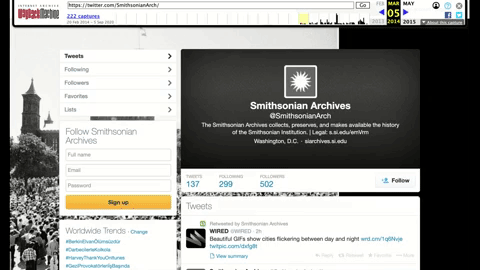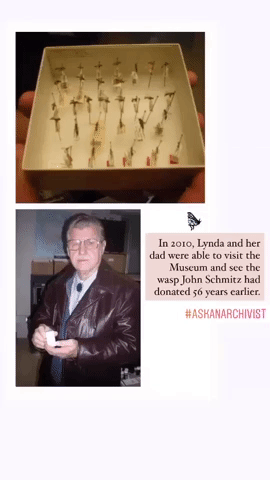We kicked off American Archives Month with another successful #AskAnArchivist Day on social media. We rallied a team and headed to Twitter and Instagram to answer all of your burning questions.
As you might imagine, this year was a little different. Instead of bopping around the office, poking our heads around workspaces for quick answers and to make silly GIFs, we had to rely on our office group chat. Shout out to William Bennett, Marguerite Roby, Lynda Schmitz Fuhrig, Deborah Shapiro, Kira Sobers, and Mitch Toda, who were on standby all day to share their expertise. One slight advantage of this new way of communicating is that there were a surplus of answers that didn’t quite make their way to social media during the day. We’re sharing those bonus answers here.
Let’s start off with a fun one.
Archivists, if you could pick one task to start your workday with, what would it be?
Marguerite: I like to start my workday with a solid hour of uninterrupted cataloging!
Mitch: Drink a cup of coffee.
Kira: Ideally, I would like to start my workday by digitizing a cool/interesting/new audio or video recording.
Deborah: In the summer, I like to cool off from my morning commute in collections storage.
If you know, you know.
What's your favorite artifact that seems mundane but has an intriguing story behind it?
Lynda: My favorite artifact involves my father and a donation he made to the Smithsonian in the 1950s.
Lynda’s answer brought us back to a 2010 blog post that she wrote about discovering her dad in the Archives. In 1954, John Schmitz noticed an odd hole in a Cecropia moth cocoon. He decided to send the silky case and its associated parasite (a wasp) to the National Museum of Natural History for identification, and the Smithsonian accepted the specimens as a gift. Fast forward 56 years. In 2010, Lynda and her parents were able to visit the Museum and actually see John Schmitz’s donation. A tiny label inside the tray where it lives includes the name of the moth, Schmitz’s name, and the year he donated the specimen.
What does it take to become an archivist?
Emily: We have a whole blog series about that! Hear from our archivists, conservators, web developer, and beyond.

What is the best way to store printed color photos?
William: The best advice we can offer (without knowing if you're talking digital prints or prints from film negatives) is to store them in a cool, dry place. Avoid exposure to light and fluctuations in temperature and humidity. Album storage in polypropylene sleeves is good, and even the shoebox-style method works (although an archival-quality paperboard box is a better choice!). And remember, no basements or lower levels.
Archivists, what's one thing you wish more people knew about archives, either the profession generally or your institution specifically?
Kira: I wish more people knew that our jobs involve so much more than answering research inquiries, and that answering those inquiries can take a lot more time than people think.
Marguerite: Considering the task at hand, I would say most archives are understaffed and that most archivists wear many hats (customer service AND information management).
Mitch: While more and more electronic records are being transferred to the Archives, many records that are transferred are still analog.
Deborah: Let’s share the link to the blog post about the struggles of digitization.
Other archivists understand just how complicated digitzation can be. Folks in the Twitterverse shared some good responses and gave the post a lot of love.
How do you archive old technologies like cassette tapes?
Kira: We have two cassette decks that hook up to an ADC (analog-to-digital converter) that hooks up to a computer. Software on that computer is used to pull in the signal and save it as a Broadcast WAVE file.
How many tech jobs are in digital archiving? Like um...how do you study for that? Why would digital archives be important?
Lynda: Having technical knowledge is a plus with digital archiving, from knowing how to use the command line to being familiar with various file formats and older software and hardware. Many programs now have classes on coding, web archiving, and digital curation and preservation. Digital archives are important because they can contain information that is not found in the analog realm.
What would archiving look like 10-15 years from now?
Mitch: One thing, is that collecting, collections, and descriptions will be more diverse and inclusive.
Mitch’s point felt like a good time to share a recent blog post from Smithsonian Data Science Lab about how intern Tiana Curry revisited metadata and determined that specimens collected by naturalist Mary Vaux Walcott had been misattributed to her husband...years after his death.
What would archiving look like 10-15 years from now?
Lynda: It will become even more digital and personal as people continue to rely on documenting life through social media platforms and devices.

And the Smithsonian Institution Archives is here to capture that digital history. On that great, last note, we said goodbye to the 2020 #AskAnArchivist Day, but reminded our followers that our experts are only a DM (direct message) away!
Related Resources:
- “#AskAnArchivist 2019: The Year of the GIF,” by Emily Niekrasz, The Bigger Picture, Smithsonian Institution Archives
- “#AskAnArhivist 2017: You Asked, We Answered,” by Effie Kapsalis, The Bigger Picture, Smithsonian Institution Archives
- “You Asked, We Answered: 2015 Ask an Archivist,” by Effie Kapsalis, The Bigger Picture, Smithsonian Institution Archives
Produced by the Smithsonian Institution Archives. For copyright questions, please see the Terms of Use.





Leave a Comment